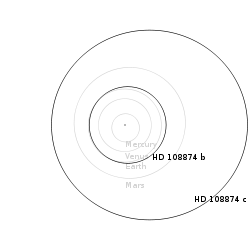HD 108874
 Orbits around the star HD108874 | |
| Observation data Epoch J2000 Equinox J2000 | |
|---|---|
| Constellation | Coma Berenices |
| Right ascension | 12h 30m 26.882s[1] |
| Declination | +22° 52′ 47.38″[1] |
| Apparent magnitude (V) | 8.76 |
| Characteristics | |
| Spectral type | G5 V |
| B−V color index | 0.764 |
| V−R color index | 0.4 |
| Variable type | ”None” |
| Astrometry | |
| Radial velocity (Rv) | –30.7 km/s |
| Proper motion (μ) | RA: 127.11 ± 0.96[1] mas/yr Dec.: –89.47 ± 0.84[1] mas/yr |
| Parallax (π) | 16.87 ± 0.24[2] mas |
| Distance | 193 ± 3 ly (59.3 ± 0.8 pc) |
| Absolute magnitude (MV) | 3.72 |
| Details | |
| Mass | 1 M☉ |
| Radius | 1.22 R☉ |
| Luminosity | 1.14 L☉ |
| Temperature | 5407 K |
| Metallicity [Fe/H] | 0.14 dex |
| Rotation | 37.82 days |
| Age | 7.26 Gyr |
| Other designations | |
| Database references | |
| SIMBAD | data |
| Exoplanet Archive | data |
| Extrasolar Planets Encyclopaedia | data |
HD 108874 is a yellow dwarf star (spectral type G5 V) in the constellation of Coma Berenices. It is 200 light years from Earth[1] and has two extrasolar planets that are possibly in a 4:1 orbital resonance.
Star
HD 108874 is 2.7 billion years older than our Sun. The star has a temperature of 5407 K and luminosity 1.14 solar. Its metallicity is 1.38 times solar, meaning it has greater iron abundance relative to hydrogen and helium. It has about the same mass as the Sun, but the radius is 22% greater.
Planetary system
In 2003, the jovian planet HD 108874 b was discovered by the US-based team Paul Butler, Geoffrey Marcy, Steven Vogt, and Debra Fischer.[3] This planet receives the amount of insolation closest to Earth of any extrasolar planet. In 2005, further observations revealed this star has another jovian planet orbiting further out, designated as HD 108874 c.[4] Those two planets are in a 4:1 orbital resonance. This means if HD 108874 b orbits the star four times, then HD 108874 c orbits only once, because the orbital period for planet c is four times longer than planet b.
| Companion (in order from star) |
Mass | Semimajor axis (AU) |
Orbital period (days) |
Eccentricity | Inclination | Radius |
|---|---|---|---|---|---|---|
| b | >1.34 ± 0.11 MJ | 1.053 ± 0.061 | 394.48 ± 0.60 | 0.128 ± 0.022 | — | — |
| c | >1.064 ± 0.099 MJ | 2.77 ± 0.16 | 1680 ± 24 | 0.273 ± 0.040 | — | — |
See also
References
- 1 2 3 4 5 van Leeuwen, F. (2007). "Validation of the new Hipparcos reduction". Astronomy and Astrophysics. 474 (2): 653–664. arXiv:0708.1752
 . Bibcode:2007A&A...474..653V. doi:10.1051/0004-6361:20078357.Vizier catalog entry
. Bibcode:2007A&A...474..653V. doi:10.1051/0004-6361:20078357.Vizier catalog entry - ↑ Martell, Sarah; Sharma, Sanjib; Buder, Sven; Duong, Ly; Schlesinger, Katharine; Simpson, Jeffrey; Lind, Karin; Ness, Melissa; Marshall, Jonathan; et al. (2016). "The GALAH Survey: Observational Overview and Gaia DR1 companion". 1609: arXiv:1609.02822. arXiv:1609.02822
 . Bibcode:2016arXiv160902822M.
. Bibcode:2016arXiv160902822M. - ↑ Butler, R. Paul; et al. (2003). "Seven New Keck Planets Orbiting G and K Dwarfs". The Astrophysical Journal. 582 (1): 455–466. Bibcode:2003ApJ...582..455B. doi:10.1086/344570.
- ↑ Vogt, Steven S.; et al. (2005). "Five New Multicomponent Planetary Systems". The Astrophysical Journal. 632 (1): 638–658. Bibcode:2005ApJ...632..638V. doi:10.1086/432901.
- ↑ Wright, J. T.; et al. (2009). "Ten New and Updated Multi-planet Systems, and a Survey of Exoplanetary Systems". The Astrophysical Journal. 693 (2): 1084–1099. arXiv:0812.1582
 . Bibcode:2009ApJ...693.1084W. doi:10.1088/0004-637X/693/2/1084.
. Bibcode:2009ApJ...693.1084W. doi:10.1088/0004-637X/693/2/1084.
External links
- Extrasolar Planet Interactions by Rory Barnes & Richard Greenberg, Lunar and Planetary Lab, University of Arizona
Coordinates: ![]() 12h 30m 26.8829s, +22° 52′ 47.383″
12h 30m 26.8829s, +22° 52′ 47.383″